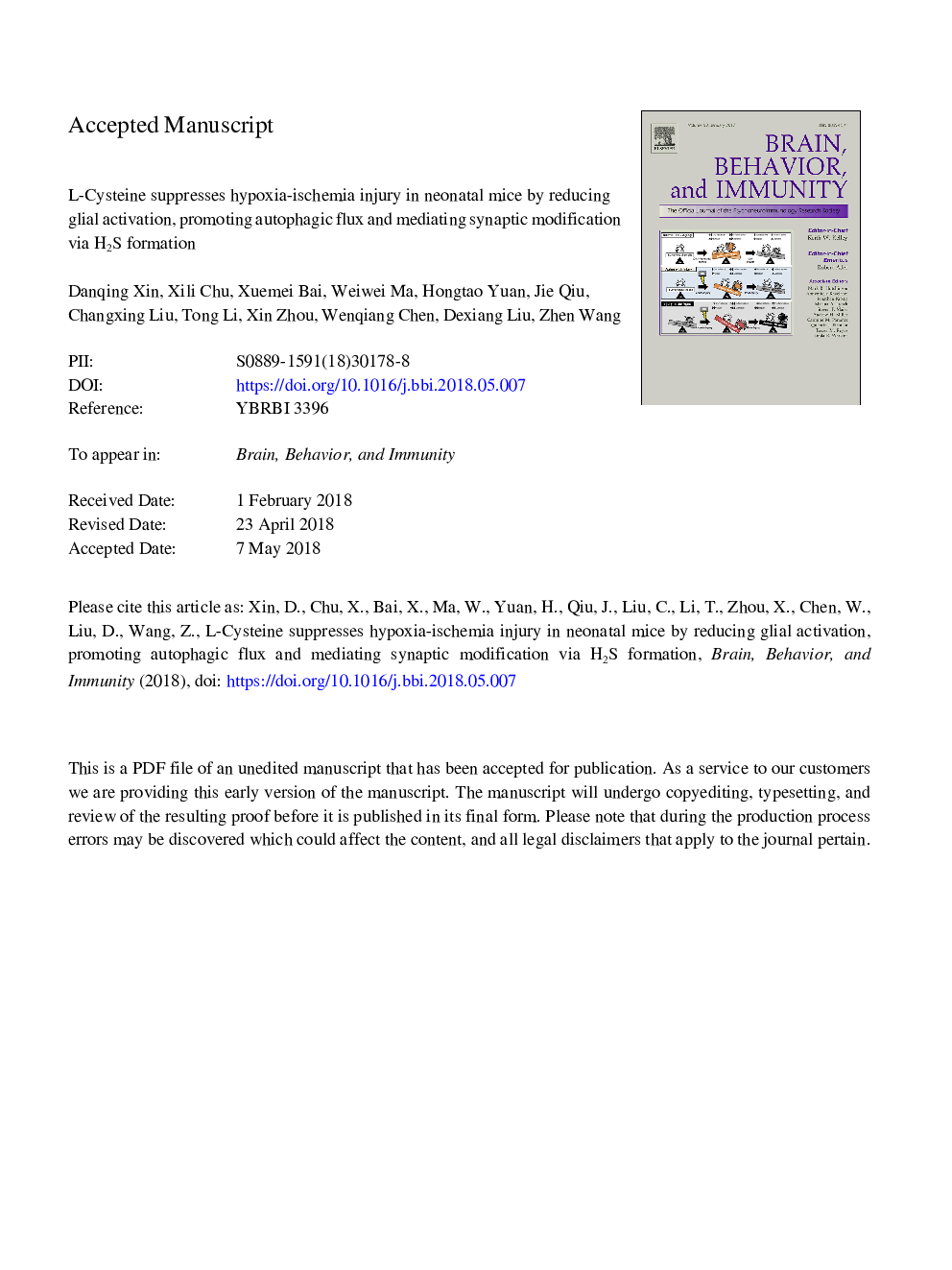| Article ID | Journal | Published Year | Pages | File Type |
|---|---|---|---|---|
| 8960736 | Brain, Behavior, and Immunity | 2018 | 52 Pages |
Abstract
We previously reported that l-Cysteine, an H2S donor, significantly alleviated brain injury after hypoxia-ischemic (HI) injury in neonatal mice. However, the mechanisms underlying this neuroprotective effect of l-Cysteine against HI insult remain unknown. In the present study, we tested the hypothesis that the protective effects of l-Cysteine are associated with glial responses and autophagy, and l-Cysteine attenuates synaptic injury as well as behavioral deficits resulting from HI. Consistent with our previous findings, we found that treatment with l-Cysteine after HI reduced early brain injury, improved behavioral deficits and synaptic damage, effects which were associated with an up-regulation of synaptophysin and postsynaptic density protein 95 expression in the lesioned cortex. l-Cysteine attenuated the accumulation of CD11b+/CD45high cells, activation of microglia and astrocytes and diminished HI-induced increases in reactive oxygen species and malondialdehyde within the lesioned cortex. In addition, l-Cysteine increased microtubule associated protein 1 light chain 3-II and Beclin1 expression, decreased p62 expression and phosphor-mammalian target of rapamycin and phosphor-signal transducer and activator of transcription 3. Further support for a critical role of l-Cysteine was revealed from results demonstrating that treatment with an inhibitor of the H2S-producing enzyme, amino-oxyacetic acid, reversed the beneficial effects of l-Cysteine described above. These results demonstrate that l-Cysteine effectively alleviates HI injury and improves behavioral outcomes by inhibiting reactive glial responses and synaptic damage and an accompanying triggering of autophagic flux. Accordingly, l-Cysteine may provide a new a therapeutic approach for the treatment of HI via the formation of H2S.
Keywords
RT-PCRPSD-95STAT3RIPAPFAPMSFHBSSCBSDAPITTCAOAALC3-IImTORGFAPCD86H2S3-MSTcluster of differentiation 86MDAphenylmethane-sulfonyl fluoride3-mercaptopyruvate sulfurtransferase4,6-diamidino-2-phenylindoled-amino acid oxidaseHanks balanced salt solutionIba-1ROSAutophagyaminooxyacetic acidinterleukintumor necrosis factor-αDAOCNSpostnatal dayradioimmunoprecipitation assayHydrogen sulfideCystathionine β synthasecentral nervous systemSynaptophysinSynTNF-αGlial activationmalondialdehydesignal transducer and activator of transcription 3ionized calcium binding adaptor molecule-1Behavioral deficitsNORTmammalian target of rapamycinSynapsehypoxic-ischemicreverse transcription–polymerase chain reactionNovel Object Recognition taskparaformaldehydeGlial fibrillary acidic proteinpostsynaptic density protein 95Reactive oxygen species
Related Topics
Life Sciences
Immunology and Microbiology
Immunology
Authors
Danqing Xin, Xili Chu, Xuemei Bai, Weiwei Ma, Hongtao Yuan, Jie Qiu, Changxing Liu, Tong Li, Xin Zhou, Wenqiang Chen, Dexiang Liu, Zhen Wang,
